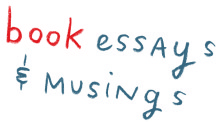Five Very Bookish Questions – author feature on Kids Book Review website (2012)
 Friday, April 19, 2013 at 4:10PM
Friday, April 19, 2013 at 4:10PM 1. Which genre of children’s books do you like most and why? Can you name a book or two in this genre that you particularly love?
Picture books are my favourite genre because there is so much going on. There are so many layers of story - in the visuals and the narrative and I enjoy the challenge of making it work in order to marry the two as seamlessly as possible. I like that there can be something for everybody - old or young. I also love picture books for their ability to tell a good story with rich, affective illustrations, sometimes with no words at all. Shaun Tan’s book The Arrival is a good example of the power of clever storytelling through strong visuals.
I am particularly attracted to well written picture books that are just plain funny - the nonsensical the better. Mr. Chicken Goes To Paris by Leigh Hobbs is off-the-wall in terms of silliness and the illustrations amplify the wonderful oddness of the whole thing. It’s deceptively clever and Leigh is a master of this type of book. Intelligent, funny picture books never get the credit they deserve.
2. Which books did you love to read as a young child?
1. Wind in the Willows, by Kenneth Graham
2. Harry The Dirty Dog, by Gene Zion
3. Everything by Roald Dahl
4. Busy, Busy World by Richard Scarry
5. Lord of The Rings by J.R.R.Tolkien
3. Which three attributes make for a great children’s book? Can you give a book title example or two?
1. For me the story has to start well; with a bang or a promise that the book is going to be a great book. The opening line (especially in a picture book) or paragraph has got to say to the reader ‘you’re going to love this book!’ Otherwise, what’s the point.
Oliver Jeffers’ opening line from his picture book Lost and Found is a good example. It begins ‘Once there was a boy and one day he found a penguin at his door.’ It asks so many questions – we have to find out what happens. Another is Tomi Ungerers’ book Adelaide. It begins: ‘Adelaide’s parents were surprised when they saw that their daughter Adelaide had wings.’ Brilliant – I’m in!
2. Well-rounded, strong character/s. The character needs to be believable, memorable and interesting if the reader is going to give them their time and invest in the story. Olivia by Ian Falconer is a great character that kids can relate to. They love her inquisitiveness and her naughty side. Plus she is interesting to look at which always helps.
3. Respect for the reader. I have trouble with books that hand feed everything to the reader, not allowing them to piece the story together themselves – spelling every detail out. It’s insulting. The reader feels much more involved in the story when they are able to form their own visuals and own summations of what they are reading. There is a greater sense of gratification for the reader when they have worked for their meal. They empathise better with the books’ characters and their journeys. They then feel more committed to turning the page.
4. What is your number one tip for encouraging children to read?
Aside from reading to them, I would say ‘be seen reading.’ Children grow up mimicking their parents and if both parents read there is a greater chance that their children will want to read too. Makes sense to me anyway.
5. Name three books you wish you’d written.
1. Where The Wild Things Are by Maurice Sendak
2. The Iron Man by Ted Hughes
3. Wind in the Willows by Kenneth Graham





Reader Comments